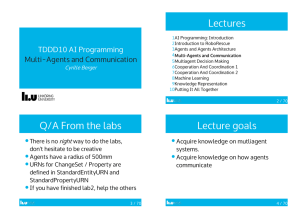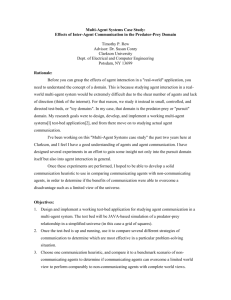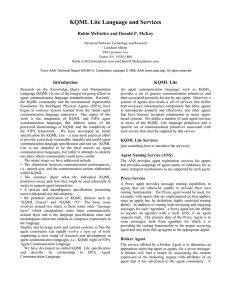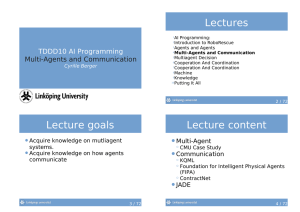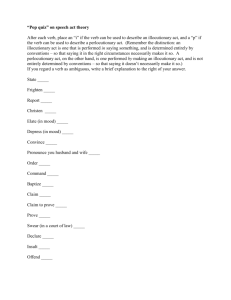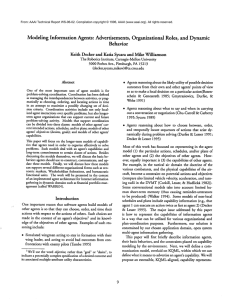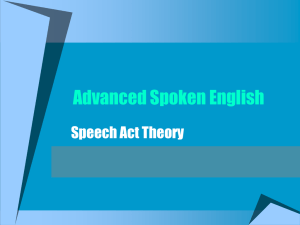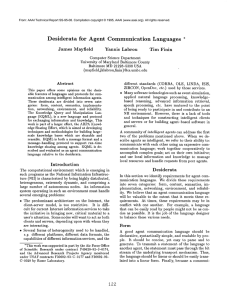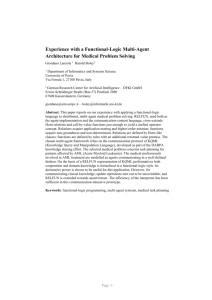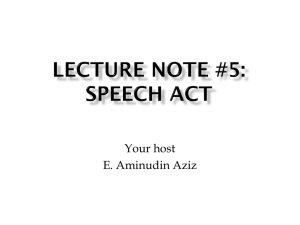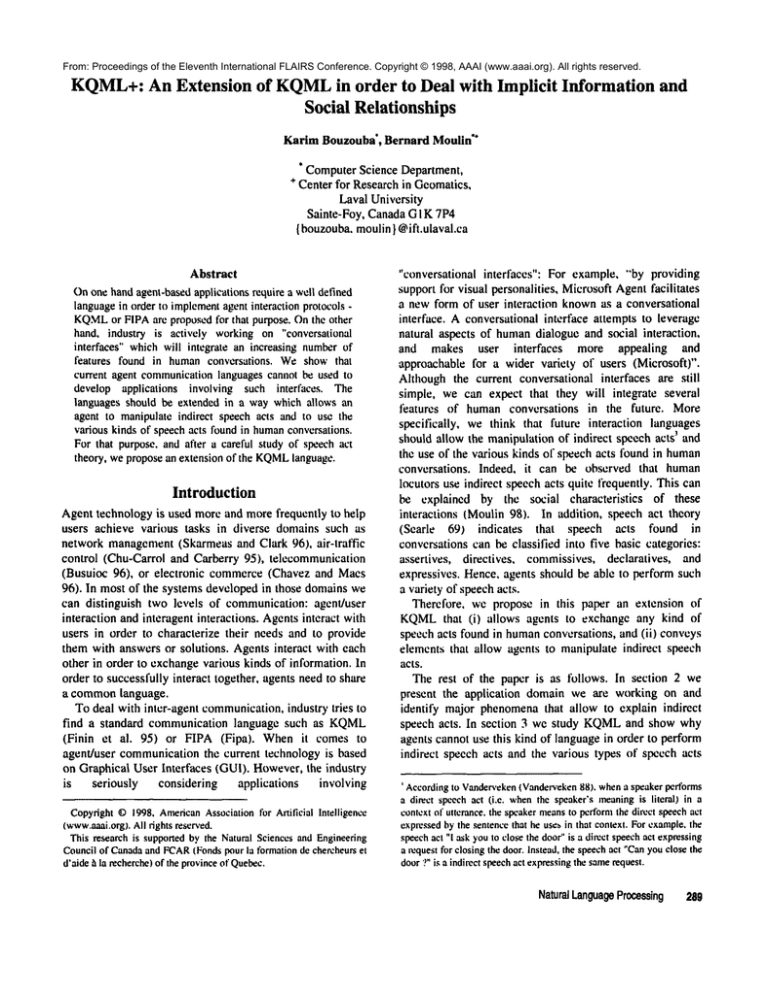
From: Proceedings of the Eleventh International FLAIRS Conference. Copyright © 1998, AAAI (www.aaai.org). All rights reserved.
KQML+:
An Extension of KQML
in order to Deal with Implicit Information and
Social Relationships
"÷
KarimBouzouba’, Bernard Moulin
* ComputerScience Department,
+ Center for Research in Geomatics,
Laval University
Sainte-Foy, CanadaG I K 7P4
{ bouzouba,moulin} @ift.ulaval.ca
Abstract
Onone handagent-basedapplications require a well defined
languagein order to implement
agent interaction protocolsKQML
or FIPAare proposedfor that purpose. Onthe other
hand, industry is actively workingon "conversational
interfaces" whichwill integrate an increasing numberof
features found in humanconversations. Weshowthat
current agent communication
languagescannot be used to
develop applications involving such interfaces. The
languages should be extended in a way which allows an
agent to manipulateindirect speech acts and to use the
various kinds of speechacts foundin humanconversations.
For that purpose,and after a careful study of speechact
theory, we proposean extension of the KQML
language.
Introduction
Agent technology is used more and more frequently to help
users achieve various tasks in diverse domains such as
network management(Skarmeas and Clark 96), air-traffic
control (Chu-Carrol and Carberry 95), telecommunication
(Busuioc 96), or electronic commerce(Chavez and Mats
96). In most of the systems developed in those domainswe
can distinguish two levels of communication: agenffuser
interaction and interagent interactions. Agentsinteract with
users in order to characterize their needs and to provide
them with answers or solutions. Agents interact with each
other in order to exchangevarious kinds of information. In
order to successfully interact together, agents need to share
a commonlanguage.
To deal with inter-agent communication,industry tries to
find a standard communication language such as KQML
(Finin et al. 95) or FIPA (Fipa). Whenit comes
agent/user communicationthe current technology is based
on Graphical User Interfaces (GUI). However,the industry
is seriously considering
applications
involving
Copyright
©1998.American
Associationtbr Artificial Intelligence
(www.aaai.org).
Alllights reserved.
This re,arch is supportedbythe NaturalSciencesand Engineering
Councilof CanadaandFCAR
(Fondspourla formationde chereheurset
d’aide~t la recherche)
of the province
of Quebec.
"conversational interfaces": For example, "’by providing
support for visual personalities, MicrosoftAgentfacilitates
a new form of user interaction knownas a conversational
interface. A conversational interface attempts to leverage
natural aspects of humandialogue and social interaction,
and makes user interfaces
more appealing
and
approachable for a wider variety of users (Microsoft)".
Althoughthe current conversational interfaces are still
simple, we can expect that they will integrate several
features of human conversations in the future. More
specifically, we think that future interaction languages
should allow the manipulationof indirect speech acts ~ and
the use of the various kinds of speech acts found in human
conversations. Indeed, it can be observed that human
locutors use indirect speech acts quite frequently. This can
be explained by the social characteristics
of these
interactions IMoulin 98). In addition, speech act theory
(Searle 69) indicates
that speech acts found
conversations can be classified into five basic categories:
assertives, directives, commissives, declaratives, and
expressives. Hence, agents should be able to perform such
a variety of speechacts.
Therefore, we propose in this paper an extension of
KQML
that (i) allows agents to exchange any kind
speech acts found in humanconversations, and (ii) conveys
elements that allow agents to manipulate indirect speech
acts.
The rest of the paper is as follows. In section 2 we
present the application domain we are working on and
identify major phenomenathat allow to explain indirect
speech acts. In section 3 we study KQML
and show why
agents cannot use this kind of language in order to perform
indirect speech acts and the various types of speech acts
’ According
to Vanderveken
(Vandelweken
88). whena speakerpertbrms
a direct speechact (i.e. whenthe speaker’smeaning
is literal) in
contexto1"utterance,the speakermeans
to perform
the di~vetspeechact
expressed
bythe sentence
that he usesin that context.Forexample,
the
speechact "l askyouto closethe door"is a directspeechact expressing
a requestfor closingthe door.Instead.the speech
act "Canyouclosethe
door?" is a indirectspeech
act expressing
the samerequest.
NaturalLanguage
Processing
28g
fimnd in humanconversations. F’inally. in section 4 we
present the KQML+language we developed as an
extension of KQML.
Importance of implicit information and social
relationships
Administrative correspondenceis an application domainin
which our extension of KQML
can be applied. Large and
small organizati~ms use some kind of administrative
correspondencein various forms: lbrmal letters, informal
letters, menlos, notices, etc. The waythc~se dtx:umentsare
written dependson the "social relationships" established
between the interlocutors.
Messages may be "very
informar’, "very polite", or "quite informal".
In the POSTAGE
project, we develop software agents
which manageadministrative correspondenceon behalf t~t"
and in cooperation with their users. Eachuser interacts with
his own POSTAGE
agent which generates messages with
respect to administrative
corresptmdence rules. A
POSTAGE
agent is also responsible for sending the
generated message to the addrcssee’s POSTAGE
agent.
Hence, our project allows users to delegate the task of
administrative correspondenceto interlace agents
A user can formulate a messagein an intbrmal way, and
the POSTAGE
agent will transform this message in a way
which agrees: (IJ with the social relationship existing
between the user and his addressee: (2) with the user’s
communicative intention, and (3) with the f~rmulation
rules used in that particular organization. For examplethe
inlbrmal message"Your are laid off’ would be transformed
into "As general manager, 1 deeply regret having to
announce your dismissal froth our company". Moreover, a
lot of administrative messagesare expressed using indirect
speech acts such as "Canyou print this document?" instead
of using the direct speech act "Print this document".
During our study of administrative correspondence, we
identified two major phenomena: the use of implicit
inl’~rmation,and the importancet~l" social relationships.
It is easily observed that humanIocutors use indirect
speech acts more frequently than direct speech acts. For
instance, whena manager says to his secretary "Can you
print the document D45’?", his utterance should be
interpreted as a polite way of ordering her It) print the
document(non literal interpretation) and not as a question
abouther ability to print (literal interpretation). In ~wder
take into account this conversational phenomenon, we
suggested to model implicit inJbrmation conveyed by
speech acts (Bouzouhaand Moulin 97). Given a speech act
SAperformed by Ioeulor L I and directed to loeutor L2, we
define the implicit informatitm conveyed by SA as the
information that I,I intends to transfer to L2 and whichis
different from SA’spropositional content. For example, the
implicit information associated to the question "Can you
290 Bouzouba
print documentD45?" is the request to print the document.
To c~ur knowledge, no current implementation of software
agents integrates this aspect in its communication
model.
In order to provide a mapping between implicit and
explicit information, we use knowledgestructures called
conversational
schemas which are similar to the
ctmversational postulates that Gordonand l,akoff proposed
to interpret indirect speech acts (Gordonand Lakoff 75L
Conversational schemasspecify conversational conventions
that apply in a given soeio-organizational context. A
conversational schemacan be used by an agent either for
choosing a speech act that rcllects its communicative
intention, t)r for interpreting other agents’ speechacts. For
example, the conversational schemaof the above example
c~uld be formulated using the following logical
implication:
.Taes’-i on ,: speaker,
cal:aci z y : hearer,do : hearer,A ~ I )
--9
reques=: speaker,=Io ;hearer.a’.:t ion)
If we want to provide agents with the ability to perform
and interpret indirect speech acts, it is necessary to give
them means by which they can determine if their
communicative intention has been understood. In our
approach, an agent A I determines if the intention
correspondingto its initial speech act has been recognized
by the interlocutor agent A2, if A2"s speech act matches
with the expected speech act which is included in the
conversational schemathat A I selected in order to perform
its initial speechact.
There is little doubl that sm’ial rel, tionships inlluenee
the way people interpret
speech acls (Boden and
Zimmerman
91). It is easily observed that Ioeutors are
aware of the roles they play and the social powerthey have
in the organizational setting in whicha ctmversation takes
place. A soldier cannot give orders to his general without
violating the powerscale established in the army. Wecan
also notice that most often social relationships arc not
expressedin locutors" speech acts: they remainimplicit. In
certain cases however, when a social relationship is
violated, locutors react and maydecide to invoke their
social relationships: hence, they becomeexplicit. Suppose
that for whatever reason a secretary refuses to perform a
task requested by her manager, the managermay strongly
react saying: "1 am y~ur boss and you have to do what I
order you to do".
In order to model the social context in which agents
evt~lve, weprovide them,,~.ith specific mentalstates related
tt) their inter-personal relationships: their roles and the
social power induced by those relationships. A reasoning
mechanismusing those social mental states guides an agent
when selecting a conversational schemaand allows it to
perlbrm a speech act with respect to the powerrelationship
established with the other agent.
In summary, a POSTAGE agent should use a
communicationlanguage that allows it to express all kinds
of speech acts found in correspondence messages. In
addition, social relationships should be part of those
exchanged messages.
Study
of
KQML
KQMLis a communication language which has been
designed to facilitate
high-level cooperation and
interoperation among software agents. KQML
offers a
extensible set of so-called "performatives" that specify
what kinds of communication agents can have with each
other. KQML’sauthors have borrowed the notion of
performative verbs to speech act theory. Our study of
KQML
has outlined the following points:
I. KQML
performatives are limited to the assertive and
directive categories. There is no performative allowing
agents to perform declarative, expressive, or commissive
speech acts. However,without a commissiveperformative,
it is difficult to imagine how agents could cooperate.
Indeed, wheneveran agent is busy and cannot immediately
execute a requested action, it should send a commissive
message, promising the requesting agent that the answer
will be forthcoming. Hence, without the commissive
performative, the requesting agent would have no way to
knowif it will get an answerfor its request.
2. hulppropriate choice of petformatives. For example,
when an agent cannot answer to a request, it uses the
performativ¢scrry. But, sor.-’y is not a verb as should be a
performative according to speech act theory. In addition,
this performativc displays a psychological attitude of
regret. However, the agent may have no regret when
performing an act using this performative. More details
about inappropriate choice of other KQML
performatives
can be found in (Cohen and Levesque 96).
3. Illocutionarv force and propositional content of
KQMLmessages are independent. However, according to
speech act theory, the illocutionary
force and the
propositional
content of a KQMLmessage must be
dependent. For example, the propositional content of a
directive must describe a future situation. Dueto the lack
of semantics associated to KQML
performatives, this
dependency condition is not satisfied.
As Cohen and
Levesque suggested (Cohen and Levesque 96), one of the
problems related to this independency property is that
contradictions could arise. For instance, an agent could
send a message saying that it requests another agent to
perform an act, and at the same time the agent could say
that it does not want the act to be done. Thus, agents could
deny the sincerity conditions (Vanderveken 90)
preparatory conditions of their speech acts which is
unacceptable.
4. Different interpretations of KQMLperformatives.
Although KQML
is supposed to be a standard language,
several projects using it interpret differently certain
performatives. For example, in order to announce its
abilities, an InfoSleuth agent (Nodine and Unuh97) uses
teJ.J, while a Visitor-Hoster agent (Sycara and Zeng 96)
uses the adverr,±se pefformative.
Because of those limitations, the current version of
KQMLcannot be used to develop conversational
interfaces,
and we can not use for administrative
correspondence. In the POSTAGE
project, we have tried to
extend KQML
in order to overcome those limitations,
basing our proposal on a rigorous study of speech act
theory.
As a result, we propose to add new performatives and
new slots in the structure
of a KQMLmessage.
Interestingly, speech act theory (Vanderveken90) proposes
a classification of speech acts found in conversations and
we can take advantage of that classification in order to
provide a systematic interpretation of agent’s speech acts.
Briefly speaking, a speech act in speech act theory is
represented by a propositional content and an illocutionary
force. The illocutionary
force is divided into six
components.
KQML+: an extension
of KQML
One of the main problems of KQML
is the non-unique
interpretation associated with certain performatives. Each
performative verb should be carefully selected. Multiple
interpretations of a performative can be explained by the
fact that certain performative verbs used in KQML
can
belong to two different categories. For example, tell
might be either an assertive or a declarative. The multiple
interpretations can be also explained by the fact that
illocutionary
force components of some KQML
performative verbs are not neutral. In order to solve this
problem, we propose to select for each performative type,
the corresponding primitive verb as suggested by speech
act theory. In most cases, the primitive verb has only one
illocutionary point and all of its illocutionary force
components are neutral. For example, to perform a
directive, the verb direct: is the primitive performative
verb suggested by speech act theory. The selected verbs of
the other ~erformativetypes are listed in table I.
Pe~onnative
direct
assert
declare
express
commit
for
for
for
for
for
Metmin~
a directive
an assertive
a declarative
an expressive
a commissive
Table1. primitive verbs fiJr each performative type
NaturalLanguage
Processing
291
For example, in the folh)wing message, agent A requests
agent B to buy x and y products:
(direct
: sender
: receiver
: conten-,
:reply-with
agez:tA
agentE
= ),
buy:AGT(.agent_
OBJ ;product-x:
product-y
))
dl)
Tile performatives that we have just proposed allow
agents to express a simple communicative intention.
However,we arc not able to represent with these primitive
verbs more complex fornmlations ,~uch as "Wouldyou be
so kind to print that dt~cumcnt ?". Hence. the language
cannot be limited to primitive verbs; other tneans should be
found to represent more complex h)rmulations.
The
illocutionar.v
lbrce components which have a direct
influence on formulations are: the iilocutionary point, the
modeof achieve,nent, the sincerity conditions, and the
degree of strength. Thus, relying on those four components,
in addition to the propositional content, we will propose
new slots that should be added to the structure of KQML
messages. This new structure will be named a KQML+
message. Let us first look at the definition of those
components(Vandervekcn 9(7).
Illocutionarv point: when perlbrming a speech act. a
speaker has the intention to achieve its illocutionary point
on the propositional ct,ltent, because that point is tile
purpose which characterizes the type of speech act that he
pcrfornts. The ilhwtaion,r~" poblt could be namedhy using
a performative verb.
Mode of achievement: this is the component of an
illocutionary Ibrce which determines howits ilkx:utionary
point must be achieved on the propositional content when
the act is pe,’fortned withthat three. Fronl a logical point of
view, the modeof achievementrestricts tile conditions t,l"
achievementof its illocutionary point by requiring certain
specific meansor waysto achieve that point. Whe,uttering
a command for example, the speaker must invoke a
position ol" authority over the hearer. The mode of
achievement of an act of begging, which is a humble or
polite attempt to get the hearer to do sotnething, is a special
mtxte ol" achievementof the directive illocutionary point.
Hence, the modeof achievement m,ty be invoked b,tsed on
a position of authority or on persomtliU’ traits of the agent.
Sittcerit.v conditiotls: by pc,’forlning an illocutionary act.
the speaker also expresses (or exhibits)
certain
psychological attitudes (such as a regret or a desire) about
the state of affairs representedby the propositionalcontent.
For example, a speaker who promises somelhing.
expresses an intention to do what he promises, and a
speaker whorequests a hearer to do something expresses a
desire that he do it. Fornlally. a sincerity condition is a
subset of all psychological attitudes and is expressed using
Content is expressed using conceptual graphs (Sov, a 84).
292 Bouzouba
an expressive verb such a,; "1 regret tirol". Sim’eritv
conditions may be invoked by the use ~" an expressive
performative.
Degree ~" strength: psychoh,gical attitudes which are
part of the sincerity conditions of speech acts are expressed
with different degrees of strength depending o, the
illocutionary force. For exaniple, the degree of strength t)l"
sincerity condititms of a supplication is greater than thai of
a request. Adverbslike ’sincerely" t)r "frankly" strengthen
the degree t)f strength of tile sincerity conditiott. The
Degreeof strength mayI,e im’~,kedhi" the use o.[’an adverb.
Hence. according Io speech act theory, natural language
expressions are not only dependent on tile type of hc
perfi~rmative verb, but also on the modeof achievement,on
sincerity conditions and on the degree of strength. Thus, a
way of extending KQMLwould be to consider those
componentsas new slots for KQML+
messages. This is not
the solution we adopted, hldecd, the proposed conlponents
don’t emphasizesocial relationships which are necessary
fur an agent to manipulate indirect speech acts. Rather.
basing our suggestion on th(~sc components,we pr(,p(~sc
new slots Ibr the KQML+
structure message.
In the previous section, we associated to each
perforntative type a primitive verb. In certain cases, the
primitive verb might ,lot be used. The verb ar.no.znce, Ibr
example,ct)uld be used to performa declarative speech act
instead of the verb declare. To take into account our
previous remarks about the necessary ele,qcnts l’~r
manipulating indirect speech acts. we divided the modeof
achievement into twt) new slots. In I:act. tile modeof
achievementmaybe exp,’essed either by a personality trail,
such as polileness or httmilily, or by :t social position. In
general, the personality trait is asst~ciated with the
performativc verb used to e*~prcss the speech act. For
example, one can ,hake a request in a polite way. Hence.
we added to the structure of a KQML+
inessage, the .--J-~t
exIcres se~-’.:.,--r f.’:.,rtr ~ t i v.~. which
i,)cludestile pe,’f~)rmative
verb actually used in the formulation and the degree
associated with this perfi)r,native. For a polite request, this
slot will have the value :t,:.cu;~.st, pcl".te:.. Since, tile
social position is a noti(,~ whichis conceptuallydifferent
than the personality trail, weseparated the st~cial positit)n
from tile degree associated with :t performative. This
mainly allows agents to convey social relationships and
consequently to nt:tnipulate indirect speech acts. Tile
e×pres’--ed-soc~;-p¢,sitior:iS a new slot.
Sincerity
conditions and their degree of strength are used to express
certain psycholt)gical attitudes of the speaker and are
generally expressedin expressive formul:ttions such as "It’s
a great pleasure" or "1 deeply regret". Indeed, they
strengthen tile speech act. Weconsider that they makeup a
kind of "presentation packaging" of the speech acl to
perform.For example,"It’s a great pleasure" is represented
by the presentation slot and has the value
[pleasure, great). Therefore, the structure we propose for
a KQML+
message is:
( Pr/mi t ive -perfoz’mat i
: sender
?
: receiver
?
: expressed -parr errant lye
(verb, degree)
"e~reseed-soclal-relation
?
pre eent a t Ion
( expr, degree
: con~ent
propositionalcontent
: rep :y-wi th
?
: in-reply-to
?)
For example, the speech act "I thankfully ask you to send
me the parcel", is represented by the following KQML+
message:
(direct
:sender
:receiver
:expressed-performative
:content
:reply-with
I
You
(ask, thankfully)
send(AGT(Ycu:,
OBJ(parcel))
dl}
The speech act "As a general manager, I deeply regret
having to announce your dismissal from our company"
performed by A I is transmitted to A2 using the following
KQML+message:
(declare
:sender
:receiver
:expressed-performative
:expressed-social-posit
:presentation
:content
A1
A2
announce
general-manager
(regret, deep)
dismiss(AGT(Al),
PTNT(A2)))
Conclusion
In this paper, we looked at interaction languages that allow
agents to express any kind of speech act and take into
account social relationships. Weshowedsomelimitations
of the KQML
language regarding the expression of the
various kinds of speech acts found in humanconversations.
Using more carefully speech act theory, we proposed an
extension to KQML.KQML+
messages have a similar
representation as KQML’s
one but allow agents, thanks to
new performatives and slots, to perform any kind of speech
act and to conveysocial relationships which are necessary
elements for the manipulation of indirect speech acts.
Furthermore, the primitive KQML+
performative verbs
eliminate the possibility of havingdifferent interpretations
tbr each performative type.
References
D. Boden, D.H. Zimmerman,Talk and Social structure,
Berkeley: University of California Press, 1991.
C. Brassac, Speech acts and conversational sequencing,
Pragmaticsand cognition, Vol. 2, No I, 1994.
K. Bouzouba, B. Moulin, L’implicite
dans les
communications multi-agents, in Proc. of JFIADSMA’97,
Nice, France, April, pp. 63-75, 1997.
M. Busuioc, Distributed Intelligent Agents - A Solution for
the Managementof Complex Services, The Intelligent
Agents for Telecom Applications (ECAI’96) Workshop
Proc., 1996.
A. Chavez, P. Maes, Kasbah: An Agent Marketplace for
Buying and Selling Goods, Proc. of the First hztern.
Conference on tile Practical Application of hlteHigent
Agents and Muhi-AgentTechnology, London, April, 1996.
J. Chu-Carberry, S. Carberry, Conflict Detection and
Resolution in Collaboration Planning, Intelligent Agents IL
Lectures Notes in Artificial Intelligence 1037. Heidelberg:
Springer-Verlag, 1995.
P. R. Cohen, H..J. Levesque, Communicativeactions for
artificial agents, in Proc. of ICMAS’95,
pp. 65-72, 1995.
T. Finin, Y. Labrou, J. Malfield, KQMLas an agent
communicaton hmguage, Technical Report, Computer
Science and Electrical Engineering, University of
MarylandBaltimore County, September, 1995.
Fipa. Http://drogo.cselt.stet.it/fipa
D. Gordon,G. Lakoff, Conversational postulates, in Cole,
and J. L. Morgan(eds) Synu~rand Semantics, voi. 3 Speech
acts, NewYork, AcademicPress, 1975.
M. Huhns, M.P. Singh, IEEE Internet Computing, Vol. I,
No. I, January - February, 1997.
Microsoft, ActiveXTM Technologyfor interactive Software
Agents, http :llwww.microsoft.comlintdcvlagentl.
B. Moulin, The social dimension of interactions
in
multiagent systems, in proc. of the Third Australian
Workshopon Distributed Artificial Intelligence DAl’97, D.
Lukos, C. Zhang (editors), (to be published by SpringerVerlag), 1998.
M. H. Nodine, A. Unuh, Facilitating ()pen Communication
in Agent Systems: the InfoSleuth Infrastructure,
The
Fourth International
Workshop on Agent Theories,
Architectures, and Languages,Providence, RI, July, 1997.
J.R. Searle, Speech Acts, Cambridge University Press,
1969.
N. Skarmeas, K. Clark. Process Oriented Programmingfor
Agent-Based NetworkManagement,The Intelligent Agents
for Telecom Applications
(ECAI’96) Workshop
Proceeding, 1996.
J. Sowa,Conceptual structure: Information Processb~gb:
Mind and Machines, Addison-Wesley, Germany,1984.
K. Sycara, D. Zeng, Coordination of Multiple Intelligent
Software Agents, huernational Journal of Cooperative
h~)rmation Systems, vol. 5, num2 & 3, 1996.
D. Vandervekcn, Meaning and speech acts, Cambridge
University Press, 1990.
NaturalLanguage
Processing
293

